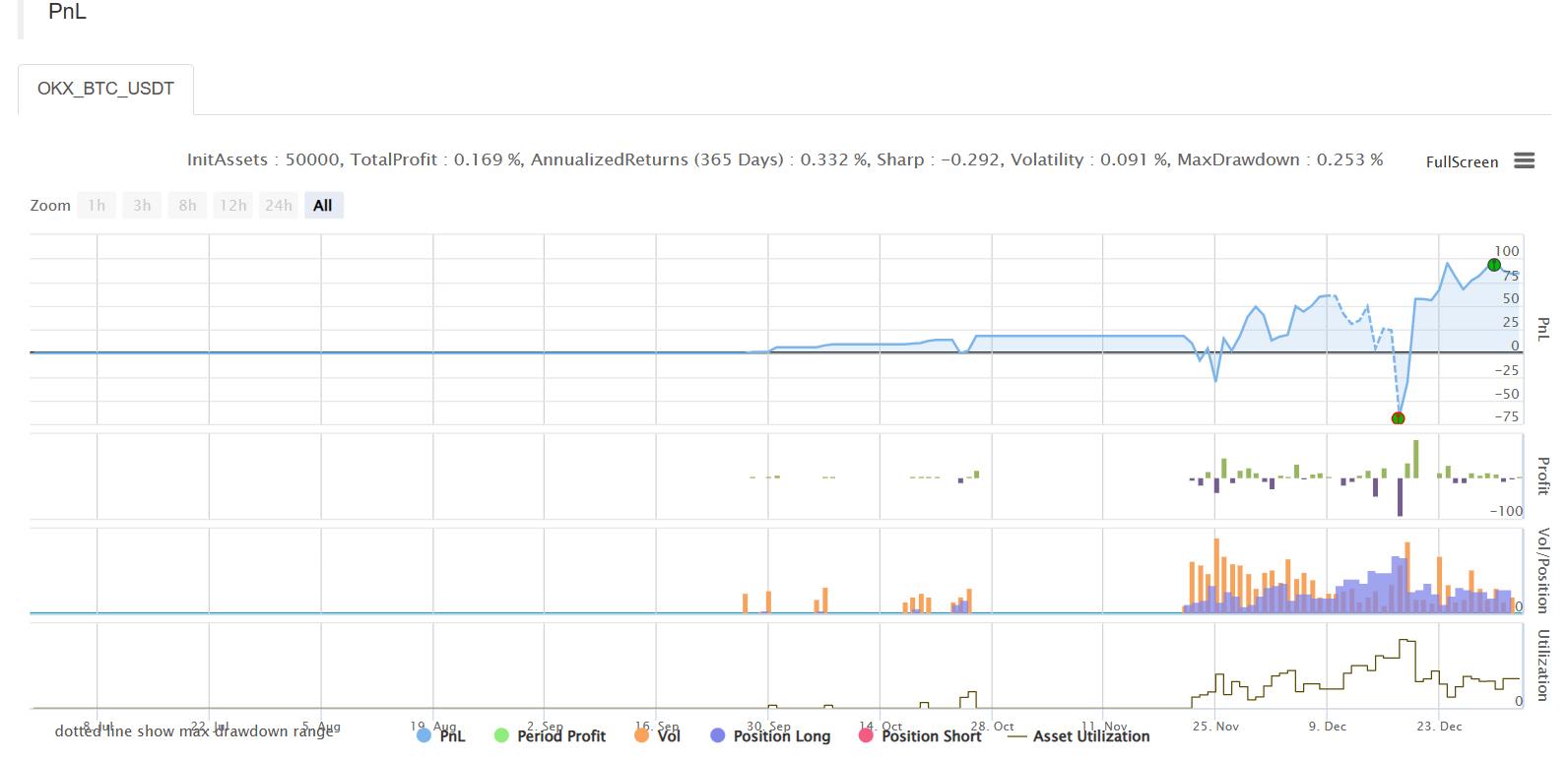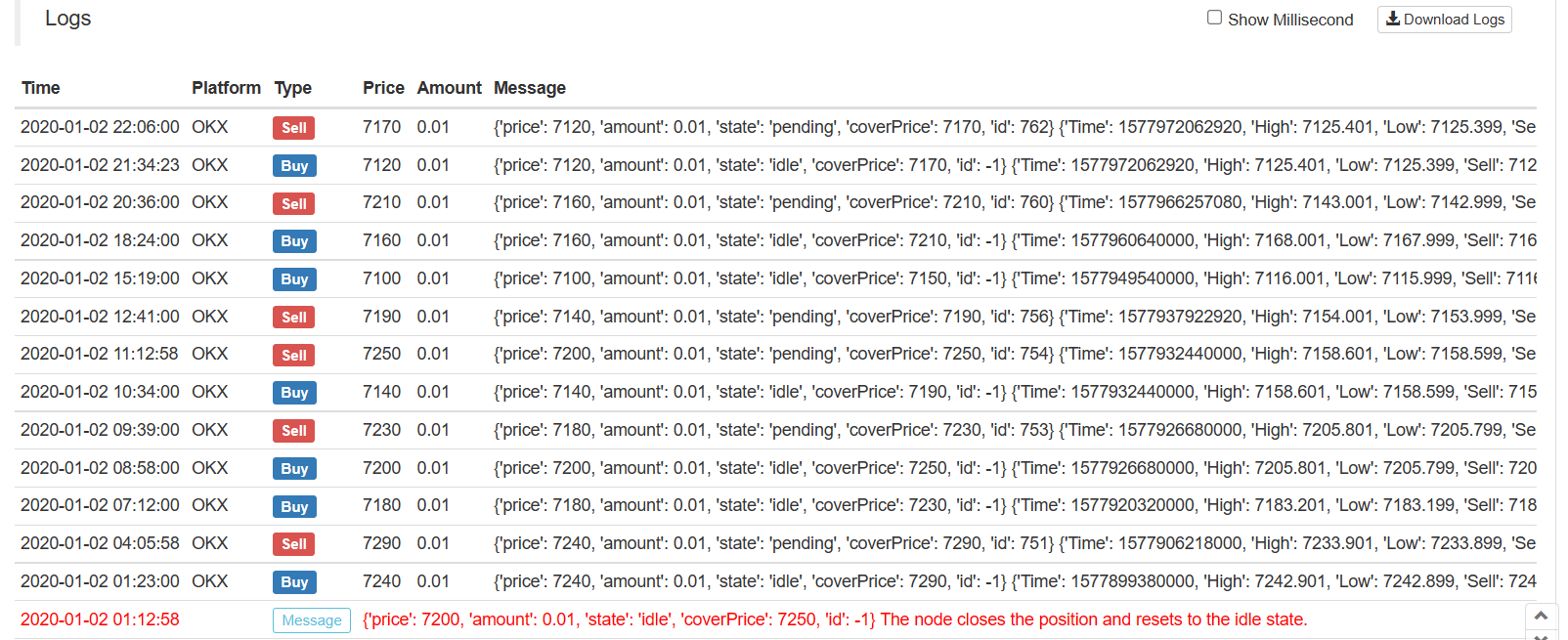Простая стратегия сетки в версии Python
Автор:FMZ~Lydia, Создан: 2022-12-23 21:00:45, Обновлено: 2023-09-20 11:17:48
Простая стратегия сетки в версии Python
Не так много стратегий Python на площади стратегии. Здесь написана версия Python стратегии сетки. Принцип стратегии очень прост. Серия сетки узлов генерируется фиксированным расстоянием цен в пределах ценового диапазона. Когда рынок меняется и цена достигает ценовой позиции сетки узлов, размещается ордер на покупку. Когда ордер закрывается, то есть в соответствии с ценой ожидаемого ордера плюс прибыльный спред, ожидается ордер на продажу для закрытия позиции.
Безусловно, риск стратегии сетки заключается в том, что любая стратегия сетки - это ставка на то, что цена колеблется в определенном диапазоне. Как только цена выходит из диапазона сетки, это может вызвать серьезные плавающие потери. Поэтому цель написания этой стратегии - предоставить ссылку для пишущих идей стратегии Python или разработки программ. Эта стратегия используется только для обучения, и она может быть рискованной в реальном боте.
Объяснение идей стратегии написано непосредственно в комментариях к коду стратегии.
Код стратегии
'''backtest
start: 2019-07-01 00:00:00
end: 2020-01-03 00:00:00
period: 1m
exchanges: [{"eid":"OKEX","currency":"BTC_USDT"}]
'''
import json
# Parameters
beginPrice = 5000 # Grid interval begin price
endPrice = 8000 # Grid interval end price
distance = 20 # Price distance of each grid node
pointProfit = 50 # Profit spread per grid node
amount = 0.01 # Number of pending orders per grid node
minBalance = 300 # Minimum fund balance of the account (at the time of purchase)
# Global variables
arrNet = []
arrMsg = []
acc = None
def findOrder (orderId, NumOfTimes, ordersList = []) :
for j in range(NumOfTimes) :
orders = None
if len(ordersList) == 0:
orders = _C(exchange.GetOrders)
else :
orders = ordersList
for i in range(len(orders)):
if orderId == orders[i]["Id"]:
return True
Sleep(1000)
return False
def cancelOrder (price, orderType) :
orders = _C(exchange.GetOrders)
for i in range(len(orders)) :
if price == orders[i]["Price"] and orderType == orders[i]["Type"]:
exchange.CancelOrder(orders[i]["Id"])
Sleep(500)
def checkOpenOrders (orders, ticker) :
global arrNet, arrMsg
for i in range(len(arrNet)) :
if not findOrder(arrNet[i]["id"], 1, orders) and arrNet[i]["state"] == "pending" :
orderId = exchange.Sell(arrNet[i]["coverPrice"], arrNet[i]["amount"], arrNet[i], ticker)
if orderId :
arrNet[i]["state"] = "cover"
arrNet[i]["id"] = orderId
else :
# Cancel
cancelOrder(arrNet[i]["coverPrice"], ORDER_TYPE_SELL)
arrMsg.append("Pending order failed!" + json.dumps(arrNet[i]) + ", time:" + _D())
def checkCoverOrders (orders, ticker) :
global arrNet, arrMsg
for i in range(len(arrNet)) :
if not findOrder(arrNet[i]["id"], 1, orders) and arrNet[i]["state"] == "cover" :
arrNet[i]["id"] = -1
arrNet[i]["state"] = "idle"
Log(arrNet[i], "The node closes the position and resets to the idle state.", "#FF0000")
def onTick () :
global arrNet, arrMsg, acc
ticker = _C(exchange.GetTicker) # Get the latest current ticker every time
for i in range(len(arrNet)): # Iterate through all grid nodes, find out the position where you need to pend a buy order according to the current market, and pend a buy order.
if i != len(arrNet) - 1 and arrNet[i]["state"] == "idle" and ticker.Sell > arrNet[i]["price"] and ticker.Sell < arrNet[i + 1]["price"]:
acc = _C(exchange.GetAccount)
if acc.Balance < minBalance : # If there is not enough money left, you can only jump out and do nothing.
arrMsg.append("Insufficient funds" + json.dumps(acc) + "!" + ", time:" + _D())
break
orderId = exchange.Buy(arrNet[i]["price"], arrNet[i]["amount"], arrNet[i], ticker) # Pending buy orders
if orderId :
arrNet[i]["state"] = "pending" # Update the grid node status and other information if the buy order is successfully pending
arrNet[i]["id"] = orderId
else :
# Cancel h/the order
cancelOrder(arrNet[i]["price"], ORDER_TYPE_BUY) # Cancel orders by using the cancel function
arrMsg.append("Pending order failed!" + json.dumps(arrNet[i]) + ", time:" + _D())
Sleep(1000)
orders = _C(exchange.GetOrders)
checkOpenOrders(orders, ticker) # Check the status of all buy orders and process them according to the changes.
Sleep(1000)
orders = _C(exchange.GetOrders)
checkCoverOrders(orders, ticker) # Check the status of all sell orders and process them according to the changes.
# The following information about the construction status bar can be found in the FMZ API documentation.
tbl = {
"type" : "table",
"title" : "grid status",
"cols" : ["node index", "details"],
"rows" : [],
}
for i in range(len(arrNet)) :
tbl["rows"].append([i, json.dumps(arrNet[i])])
errTbl = {
"type" : "table",
"title" : "record",
"cols" : ["node index", "details"],
"rows" : [],
}
orderTbl = {
"type" : "table",
"title" : "orders",
"cols" : ["node index", "details"],
"rows" : [],
}
while len(arrMsg) > 20 :
arrMsg.pop(0)
for i in range(len(arrMsg)) :
errTbl["rows"].append([i, json.dumps(arrMsg[i])])
for i in range(len(orders)) :
orderTbl["rows"].append([i, json.dumps(orders[i])])
LogStatus(_D(), "\n", acc, "\n", "arrMsg length:", len(arrMsg), "\n", "`" + json.dumps([tbl, errTbl, orderTbl]) + "`")
def main (): # Strategy execution starts here
global arrNet
for i in range(int((endPrice - beginPrice) / distance)): # The for loop constructs a data structure for the grid based on the parameters, a list that stores each grid node, with the following information for each grid node:
arrNet.append({
"price" : beginPrice + i * distance, # Price of the node
"amount" : amount, # Number of orders
"state" : "idle", # pending / cover / idle # Node Status
"coverPrice" : beginPrice + i * distance + pointProfit, # Node closing price
"id" : -1, # ID of the current order related to the node
})
while True: # After the grid data structure is constructed, enter the main strategy loop
onTick() # Processing functions on the main loop, the main processing logic
Sleep(500) # Control polling frequency
Основная идея разработки стратегии заключается в сравнении текущего списка ожидаемых заказов, возвращенныхGetOrdersАнализируйте изменения ожидаемых заказов (закрыты они или нет), обновляйте структуру данных сетки и выполняйте последующие операции. Кроме того, ожидаемые заказы не будут отменены до завершения транзакции, даже если цена отклоняется, поскольку на рынке цифровой валюты часто наблюдается ситуация с пинсами, эти ожидаемые заказы также могут получать заказы пинсов (если количество ожидаемых заказов ограничено на бирже, оно будет скорректировано).
Визуализация данных стратегии используетLogStatusфункция отображения данных на строке состояния в реальном времени.
tbl = {
"type" : "table",
"title" : "grid status",
"cols" : ["node index", "details"],
"rows" : [],
}
for i in range(len(arrNet)) :
tbl["rows"].append([i, json.dumps(arrNet[i])])
errTbl = {
"type" : "table",
"title" : "record",
"cols" : ["node index", "details"],
"rows" : [],
}
orderTbl = {
"type" : "table",
"title" : "orders",
"cols" : ["node index", "details"],
"rows" : [],
}
Первая таблица отображает информацию каждого узла в текущей структуре данных сетки, вторая таблица отображает ненормальную информацию, а третья таблица отображает фактическую информацию обмена.
Обратный тест



Адрес стратегии
Стратегия предназначена только для обучения и тестирования, и ее можно оптимизировать и обновить, если вы заинтересованы.
- Презентация о своде Lead-Lag в цифровой валюте (3)
- Введение в арбитраж с задержкой свинца в криптовалюте (2)
- Презентация о своде Lead-Lag в цифровой валюте (2)
- Обсуждение по внешнему приему сигналов платформы FMZ: полное решение для приема сигналов с встроенным сервисом Http в стратегии
- Обзор приема внешних сигналов на платформе FMZ: стратегию полного решения приема сигналов встроенного сервиса HTTP
- Введение в арбитраж с задержкой свинца в криптовалюте (1)
- Введение Lead-Lag в цифровой валюте (1)
- Дискуссия по внешнему приему сигнала платформы FMZ: расширенный API VS стратегия встроенного HTTP-сервиса
- Обзор FMZ-платформы для получения внешних сигналов: расширение API против стратегии встроенного HTTP-сервиса
- Обсуждение метода тестирования стратегии на основе генератора случайных тикеров
- Исследование методов тестирования стратегии на основе генератора случайных рынков
- Лучшие инструменты делают хорошую работу - научитесь использовать исследовательскую среду для анализа принципов торговли
- Стратегии хеджирования с использованием кросс-валюты при количественной торговле блокчейн-активами
- Приобрести руководство по стратегии цифровой валюты FMex на FMZ Quant
- Научить писать стратегии - трансплантировать стратегию MyLanguage (продвинутое)
- Научить писать стратегии - пересадить стратегию MyLanguage
- Научить вас добавить поддержку многографика к стратегии
- Научить вас писать функцию синтеза K-линии в версии Python
- Анализ стратегии Дончианского канала в исследовательской среде
- Когда FMZ сталкивается с ChatGPT, вспомните о попытке использовать AI для обучения количественной транзакции
- Изготовленный инструмент количественной торговли опционами на цифровую валюту
- Линейная стратегия потока ожидаемых заказов, разработанная на основе функции воспроизведения данных
- Стратегия покупки победителей версии Python
- FMZ Journey - с Стратегией перехода
- Научить вас преобразовывать одновидовую стратегию Python в многовидовую
- Реализовать количественный торговый робот с заданным временем старта или остановки гаджета с помощью Python
- Oak учит использовать JS для интерфейса с расширенным API FMZ
- Вызвать интерфейс Dingding для реализации сообщения робота push
- Сбалансированная стратегия ожидания (стратегия обучения)
- Мысли о движении активов через стратегию хеджирования контрактов
- Много лет спустя вы обнаружите, что эта статья является самой ценной в вашей инвестиционной карьере - узнайте, откуда берутся доходы и риски